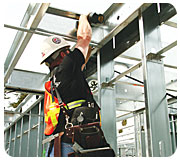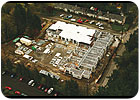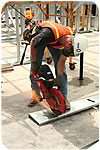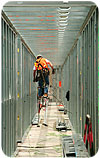
This feature article is a case study of a project in the Seattle area where a condominium project was slated to be built out of wood framing members but was switched to steel framing in the final stages of design. And while this story is interesting because it all happened in Timberland, it is also happening in other parts of North America.
Contractors tend to be creatures of habit; if they frame with wood, they tend to stay with wood. Architects are more progressive but often lack the comfort level of working with steel. Some manufacturers are working with architects and contractors to them understand steel framing. Dietrich Metal Framing is one that has dedicated itself to the promotion of steel framing and has gone the extra step to convert current wood-frame designs to steel framing. The company has created Dietrich Design Group and combined to offer design services and a line of innovative products to help the wall and ceiling contractor increase their market share of the mixed-use and condominium building industry.
The benefits of steel framing over wood have been known for years. Unlike lumber, steel is not susceptible to rot, cracks, splits or warping and it stays strong and straight for life. Steel is also the only known product that can naturally resist mold and insect infestation. By framing in cold-formed steel, builders can significantly reduce their liability to mold claims and owners may receive insurance discounts. Since wood framing is susceptible to damage from microbial growth and steel framing is not, architects are more interested than ever to convert projects from wood to steel. They just need that confidence level to work with steel and a little engineering help.

Where the wood is
The construction market is booming in Washington State with an explosion of new condominiums and other multi-living facilities. Western Partitions, a large subcontractor that employs roughly 600 workers nationwide and has three satellite offices and projects in Washington, Oregon, Idaho, California, Alaska and Hawaii. The company is continually growing and looking for new opportunities in the wall and ceiling industry, and specializes in drywall, lath and plaster, acoustical ceilings, spray applied fireproofing and metal stud construction.Western Partitions was contracted to do the framing for one of these projects that was originally slated to be wood framed and then converted by DDG to cold-formed steel. The contract for Western Partitions was to do the complete framing, exterior sheathing and an interior shear wall system (using CEMCO's Sure-Board).
"We were asked to work in conjunction with Dietrich to engineer, fabricate off-site panels and install on site," says Jeremy Gibson, operations manager at Western Partitions' Fife office. "That started us out on the construction site essentially with the installation of embedded steel plates before the concrete slab was poured for the hold down system of the building to the foundation."
Western Partitions was lucky to have a facility directly behind the project where the prefabricated panels could be put together in assembly-line fashion. Dietrich's Bruce Ward and Rick Amundson worked closely with Western Partitions and helped supply material and the panelized drawings for the job site.
Gibson says when the company received the full set of contract documents that consisted of layout and panel drawings, Western Partitions started fabricating the panels, and then waited until after the imbedded plates in the concrete slabs were set to ensure accuracy and proper alignment of the prefabricated panels. The cure time for the slab allowed Western Partitions time to fabricate panels in the shop, with no down time. The company then took a complete panelized system of the building-all load-bearing walls-and began erection of walls and floors on the building site.
According to DDG structural engineers, "The all load-bearing wall system is one of the advantages of this type of construction. Being that all walls are load-bearing, the weight is distributed uniformly around the building as opposed to concentrated points of stress as with standard systems."
This does not even take into account the weight that has been removed from the structure to additionally minimize stress.
Because of the close proximity, Western Partitions was able to use a crane on site to move the panels. From there, the crew began erecting the panel wall system by following a simple layout plan. Joists are then layed on top of these wall panels and then decking is placed over the joists. The process of this system is repeated on the next floor with no delay. This method has been done on buildings up to eight floors in height.

All floors are not created equal
The Seattle project also incorporated Dietrich's TradeReady Floor Joist system. These joists feature large extruded holes that accommodate HVAC, mechanical, plumbing and sprinkler runs. While it would seem that these larger holes might weaken the joist, they are actually stronger than a traditional joist. The hole is formed by punching the steel and allowing the metal to curve inward, much like a porthole in a ship. In fact, the technology was derived from the manufacture of submarines.Additionally, it features a series of smaller holes for electrical and technology lines. Pre-spaced joist tabs for the rim joists make layout and installation of the spanning joists extremely accurate and a snap. The steel joists are precision manufactured from corrosion-resistant galvanized steel. Made to offer consistent quality, and high strength to weight ratio, they are dimensionally stable. The joists can be used with other building materials, such as structural steel, concrete, ICF and wood construction.
Beyond its workability, contractors like its benefits down the road. Because the floor joist system is much straighter and steadier, it is also a benefit for sound control, as steel is more sound attenuating than wood or concrete. These joists also eliminate the squeaking common with wood framing. For units like condos, hotels, apartments and the like, this is a selling point for buyers that demand optimal noise control. The floors are also much flatter than wood floors, which can be crowned or bow over time.
One major benefit of the TradeReady system is the elimination of the traditional concrete floor system, although they can be used with lightweight concrete. The weight of traditional materials that is eliminated can make substantial changes in engineering calculations and save money.
"We've had a lot of limitations in building here in Seattle, with inclement weather and high winds constraining us," says Gibson. "If you go with a concrete building, you've got to pour floors and have shoring to temporarily support the floor and the shoring cannot be removed until there are three floors above. So, the subcontractors can't allow anybody on the floors until shoring is removed; this wastes precious time.
"Then through the winter, you've got to deal with concrete floor issues and if you're dealing with finished slabs, rain is always a problem," Gibson continues. "Pools of water on the concrete floors create potential wet gypsum panels which in turn make higher humidity and can create joint taping delays combined with potential mold issues."

Need speed
On more traditional types of support systems, such as structural steel and concrete and wood framing, workers have to wait for the concrete floors to cure prior to installing the walls onto the new concrete. With the TradeReady system, a crew can continue to work without interruptions and disrupting the schedule."Once we roll the joists and lay the decking, we're able to work on the next floor and stand up another stage of panels and repeat this by doing another roll of joists and decking," says Gibson. "Orchestrating this is easier than stick built: You can scale down the crew size when using prefabricated panels because the team is building out complete. So, you're standing up walls that are completed instead of having to fabricate and adjust on site."
Gibson also implies that the insurance benefits are better using steel instead of stick frame. He encourages contractors to look into this system. He likes panelized systems' safety factor, the repetitive building process, the consistency of units and time saving for construction days.
Gibson is impressed that it only took his crew 95 days to build the 135,000-square-foot condominium complex. The project began in October and was mostly complete by January. Those being the colder and wetter months, it was not an ideal time to begin building and the project would have certainly taken longer using more conventional building practices.
"It was uncharted waters for us-especially myself," Gibson says. "Time is the biggest benefit. We turned over the building quickly to allow the trades to get in there. That, in the end, saves the owner."
Thanks to Mark Fowler and Tiina Freeman for assistance.
If you read this article, please circle number 170.




